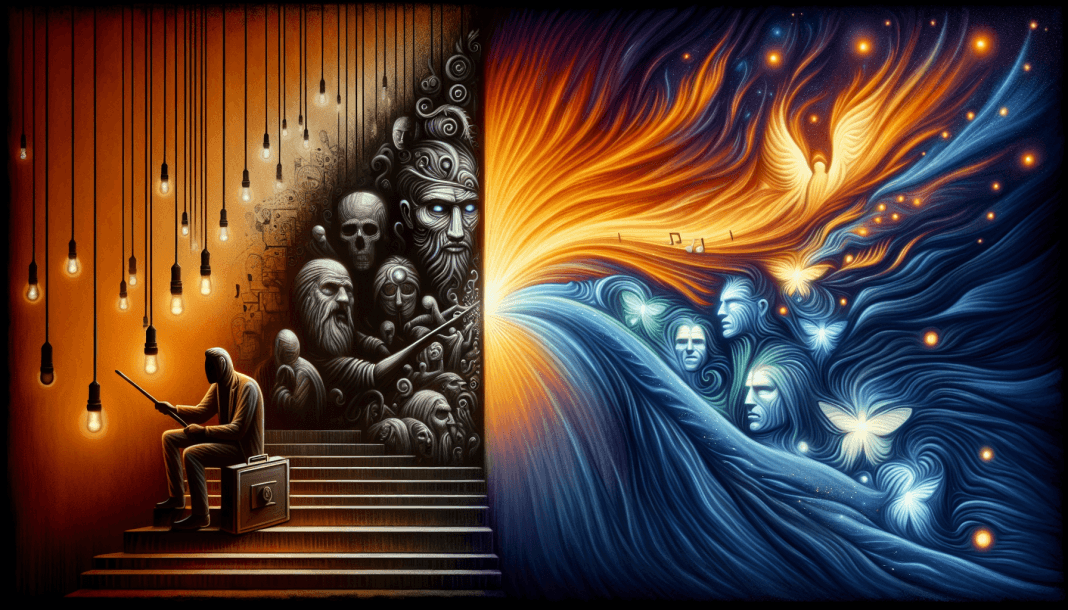In 2024, the image of the tortured “Beautiful and Damned” artist is no longer sustainable.
Discover why this stereotype is outdated and what the new trends in the art world are.
The image of the “Beautiful and Damned” artist has fascinated the public for decades. This stereotype, which depicts the artist as a tortured and rebellious figure, has significantly impacted the perception of art and artists. However, in 2024, this image is no longer sustainable.
Social, cultural, and technological changes have transformed the way we see and appreciate art, making the myth of the “Beautiful and Damned” artist obsolete.
- Origine del mito
- Cambiamenti sociali e culturali
- L’impatto della tecnologia
- Nuove tendenze nell’arte
- Case Studies
- Conclusione
Origin of the Myth
The myth of the “Beautiful and Damned” artist has deep roots in art history, originating from the Romantic conception of the artist as a solitary, tormented, and genius figure. This stereotype, which associates personal suffering with creativity, has been embodied by numerous artists over the centuries and continues to exert a persistent allure in contemporary culture.
One of the most emblematic examples is Vincent van Gogh, whose troubled life and struggle with mental illness have become integral parts of his legend. Van Gogh, who died at just 37, produced some of the most influential works in art history, and his tormented existence has fueled the idea that suffering can be a source of artistic inspiration.
Similarly, Edgar Allan Poe, master of the gothic and macabre tale, lived a life marked by personal tragedies and addictions. His work, characterized by themes of death, madness, and mystery, has often been interpreted as a reflection of his tormented experiences. Poe became a symbol of the cursed artist, whose genius is inextricably linked to his suffering.
In the 20th century, the figure of Kurt Cobain, frontman of Nirvana, represented a further incarnation of this myth. Cobain, who battled depression and addictions until his suicide at 27, was idolized as the emblem of the rebellious and self-destructive musician. His music, infused with melancholy and rage, was seen as a direct expression of his inner turmoil.
This stereotype of the “Beautiful and Damned” artist has been further fueled by the media and popular culture. Films, biographies, and articles have often emphasized the most dramatic and tragic aspects of artists’ lives, contributing to the romanticization of the rebellious and self-destructive artist image. This representation has found fertile ground even in contemporary culture, where suffering and transgression are often celebrated as signs of authenticity and artistic depth.
However, it is important to recognize that this myth can have problematic consequences. Glorifying suffering and self-destruction can perpetuate harmful ideas about the mental health and well-being of artists. Moreover, it risks reducing the complexity of human and artistic experiences to a romantic cliché, overlooking the multiple facets of creativity.
In conclusion, while the myth of the “Beautiful and Damned” artist continues to exert a powerful allure, it is essential to adopt a critical and mindful view of these narratives, recognizing both their capacity to inspire and their potential risks.
Social and Cultural Changes
In recent decades, social and cultural changes have challenged the image of the “Beautiful and Damned” artist. This romantic figure, embodying the tormented genius and the cursed artist, has long been idealized in both literature and media. However, the growing awareness of mental health has led to a greater understanding of the challenges artists face, contributing to a critical reevaluation of this stereotype.
In the past, suffering and self-destruction were often seen as intrinsic components of the creative process. Artists like Vincent van Gogh, Sylvia Plath, and Kurt Cobain were mythologized as examples of creative geniuses whose art was inextricably linked to their personal suffering. However, recent studies in psychology and mental health have shown that these romanticized views are not only misleading but can also be harmful.
Society now recognizes the importance of mental and physical well-being, and the idea that suffering is necessary for creativity has been widely discredited. Organizations like the National Endowment for the Arts in the United States and the Italian Association for Artists’ Mental Health actively promote artists’ well-being, offering resources and support for dealing with mental health issues. Additionally, many artistic and academic institutions are implementing psychological support programs for their members.
The paradigm shift is also evident in media and popular culture. Modern TV series, films, and documentaries tend to depict artists in a more complex and realistic way, acknowledging their struggles without glorifying suffering. For example, the film “A Beautiful Mind” tells the story of mathematician John Nash, highlighting both his intellectual contributions and his battles with schizophrenia, without romanticizing his suffering.
Moreover, public conversation on social media has amplified awareness of mental health. Platforms like Instagram and Twitter have become spaces where artists can share their personal experiences and find community support. Celebrities and influencers in the art world, like Lady Gaga and Demi Lovato, have openly discussed their mental health experiences, helping to normalize these conversations and reduce associated stigma.
In summary, contemporary society is increasingly recognizing the importance of mental and physical well-being for artists. The old notion that suffering is a prerequisite for creativity has been replaced by a more balanced and compassionate view, valuing health and well-being as fundamental to realizing true creative potential.
The Impact of Technology
The technology has had a significant impact on the art world. Digital platforms have democratized access to art, allowing more people to create and share their work. This has led to a greater diversity of voices and styles, challenging the idea that art must be created by tormented individuals. Additionally, technology has made it easier for artists to manage their careers, reducing the stress and isolation that often accompany an artistic life.
New Trends in Art
The new trends in art reflect these changes. Contemporary artists are increasingly interested in themes such as sustainability, inclusivity, and social justice. These themes require a collaborative and positive approach, rather than isolation and suffering. Additionally, artists are exploring new media and technologies, such as virtual reality and artificial intelligence, which demand technical skills and an innovative approach.
Case Studies
To illustrate these changes, let’s consider some examples of contemporary artists who are challenging the “Beautiful and Damned” artist myth.
- Marina Abramović: Conosciuta per le sue performance provocatorie, Abramović ha sempre sottolineato l’importanza della disciplina e della preparazione fisica e mentale nel suo lavoro.
- Ai Weiwei: Questo artista cinese utilizza la sua arte per affrontare questioni politiche e sociali, dimostrando che l’arte può essere uno strumento di cambiamento positivo.
- Olafur Eliasson: Le installazioni di Eliasson esplorano temi come il cambiamento climatico e la sostenibilità, mostrando come l’arte possa essere utilizzata per sensibilizzare il pubblico su questioni globali.
Conclusion
In conclusion, the image of the “Beautiful and Damned” artist is no longer sustainable in 2024.
Social, cultural, and technological changes have transformed the way we see and appreciate art, rendering this stereotype obsolete.
Contemporary artists are challenging this image, demonstrating that creativity can thrive in a positive and collaborative environment. The future of art is bright and inclusive, and the idea of the tortured artist is now a thing of the past.
For more insights, you can read articles on Artsy, The Art Newspaper, and Artnet.




